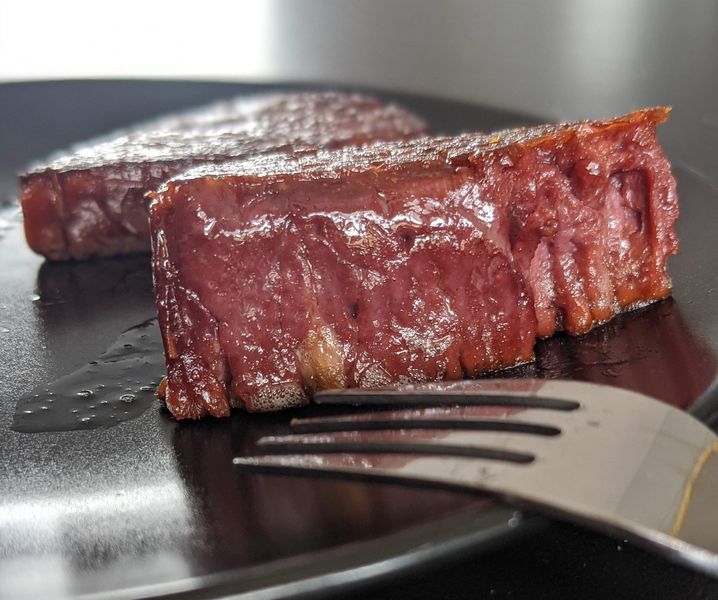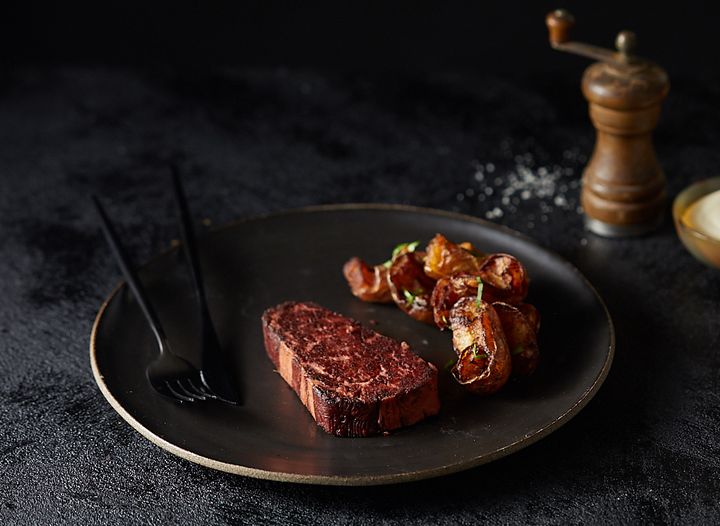
After my discussion with Redefine Meat’s Daniel Dikovsky, I had some further thoughts about what their technology could mean.
Redefine Meat has spent several years examining the muscle structure to determine a formal way to engineer and 3D print different styles of meat. Their first product is a steak-analog made from plant material that apparently is so realistic it can fool 80% of those tasting it.
During the discussion I realized there were some implications of their discoveries that are quite interesting.
Tuning 3D Printed Food
It seems that while there are many meat-analog products on the market already, like Impossible Foods, for example, they are not particularly sophisticated. That product is “tuned” to be a hamburger and is best eaten between some buns. If you were to eat it in another way it would not perform like actual meat.
Redefine Meat set out to develop a method of 3D printing “raw meat” that would behave correctly in a variety of typical culinary scenarios. That’s a vastly more complex problem to solve, and Redefine Meat feels that if they can solve that, then producing other types of meat would be “easy”.
I asked Dikovsky what was the most challenging obstacle to developing their 3D printed meat system, and he gave me an unexpected reply.
He explained that their most difficult challenge was to define what meat actually is. It turns out that there are many parameters involved in engineered meat, and even if you think you have them set correctly, you’re not done.
That’s because Redefine Meat discovered that the formula they initially devised was not optimal when tested by eaters from other regions. It turns out that meat, and specifically how people perceive the taste, varies by region.
Redefine Meat realized they had to tweak their print parameters slightly in order to make a product optimal for each market. But, due to the systematic nature of their process, that is an easy thing to do once you have defined “meat”. Thus you can understand their challenge.
A Universal Meat 3D Printer

Nevertheless, what comes from this is the understanding that they have a machine that can literally produce different types of meat on demand. By adjusting the print parameters — which in sequence deliver differing ratios of fats, proteins and other ingredients — they can produce different meat-analogs.
Then we begin to see the implications here. Imagine if a meat distributor in, say, Cincinnati, has one of the Redefine Meat machines and is using it to produce “US Midwest”-style steaks with the appropriate parameters from Redefine Meat.
What if that distributor wanted, for a special event, to produce Greek-style meat instead? They would only require a different “meat profile” from Redefine Meat, which could be transmitted electronically. There would be no need to physically ship meat from Greece to Ohio; it would be produced on-site and, presumably, be about the same taste and texture as actual Greek meat. That’s astounding.
One can then imagine these worldwide meat distributors equipped with a variety of meat profiles that enable them to produce basically any kind of meat desired on demand. Perhaps a distributor could have seven machines making Midwest steaks, but another machine making Philippine beef and another making a West African variety?
Would meat consumers warm to the idea of buying high-quality exotic meats that they would otherwise never have the chance to taste? I’d certainly give it a try.
There’s more.
Meatify
The meat profiles need not be limited to existing meats, although they would likely be the main flavor inspiration at the beginning. However, over time it would be realized that, like a computer program, the meat profile could be designed to produce all manner of interesting output, even if the 3D printed meat has no physical equivalent.
In other words, this machine could 3D print meat that has NEVER EXISTED.
What might an extinct dinosaur have tasted like? Maybe you will find out with a new meat profile. Or perhaps there could be a mixture something entirely new that no one has ever tasted?
There are likely a near-infinite number of combinations of meat profiles, and then comes another implication: the Digitization of Meat.
Like plastic and metal 3D printers, the 3D model becomes more important than the machine and the materials. The 3D model is the valuable part of the system, because it can be produced infinitely.
It may come to pass that the production of meat profiles becomes a thing in the future, just like today’s digital products: music, videos, 3D models, etc. Eager (and hungry) consumers might anxiously await the latest meat profile release from their favorite food artist.
I wonder what they will call the “Spotify” of meat?
Via Redefine Meat

